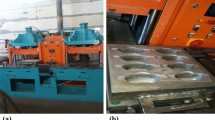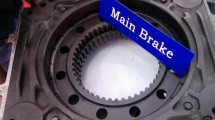Abstract
The effect of palm fiber on properties of automotive brake composite materials is analyzed. The test procedure followed is JASO C 406, which is for passenger car pads. Tribological properties of three brake pads (6 PF, 8 PF and 10 PF) were tested on full-scale inertia dynamometer for various performance parameters such as pressure–speed sensitivity (effectiveness studies) and Temperature sensitivity (fade and recovery behaviour). A pad undergoes all the testing parameters and maintains its low temperature rise in the disc for three pressure sensitivity and two temperature sensitivity tests. By increasing palm fiber content, hardness, heat swell and specific gravity increases, and also porosity and loss on ignition decreases. Test has been conducted using scanning electron microscope to analyse the all three specimens to evaluate the contact plateaus and wear debris during braking. 8% of palm fiber content in brake pad was found to be superior to 6 PF and 10 PF in most of the important tribological properties.









Similar content being viewed by others
References
Patnaik Amar, Kumar Mukesh, Bhabani K, Satapathy Bharat S, Tomar (2010) Performance sensitivity of hybrid phenolic composites in friction braking: effect of ceramic and aramid fibre combination. Wear 269:891–899. https://doi.org/10.1016/j.wear.2010.08.023
Ruzaidi CM, Kamarudin H, Shamsul JB, Mustafa Al Bakri AM, Rafiza AR (2011) Comparative study of thermal, compressive, and wear properties of palm slag brake pad composites with other fillers. Aust J Basic Appl Sci 5:790–796. https://doi.org/10.4028/www.scientific.net/AMR.328-330.1636
Ramousse S, Hoj JW, Sorensen OT (2001) Thermal characterization of brake pads. J Therm Anal Calorim 64:933–943. https://doi.org/10.1023/A:1011575013779
Ganguly A, George R (2008) Asbestos free friction composition for brake linings. Bull Mater Sci 31:19–22. https://doi.org/10.1007/s12034-008-0004-6
Cho KH, Cho MH, Kim SJ (2008) H Jang (2008) Tribological properties of potassium titanate in the brake friction materials; morphological effects. Tribol Lett 32:59–66. https://doi.org/10.1007/s11249-008-9362-x
Ficici F, Durat M, Kapsiz M (2014) Optimization of tribological parameters for a brake pad using Taguchi design method. J Braz Soc Mech Sci Eng 36:653–659. https://doi.org/10.1007/s40430-013-0115-x
Chan D, Stachowiak GW (2004) Review of automotive brake friction materials. Proceed Inst Mech Eng Part D J Auto Eng 218:953–966. https://doi.org/10.1243/0954407041856773
Cho MH, Kim SJ, Basch RH, Fash JW, Jang H (2003) Tribological study of gray cast iron with automotive brake linings: the effect of rotor microstructure. Tribol Int 36:537–545. https://doi.org/10.1016/S0301-679X(02),00260-8
Esswein JAL Jr, Arrieche FE, Schaeffer L (2008) Analysis of wear in organic and sintered friction materials used in small wind energy converters. Mater Res 11:269–273. https://doi.org/10.1590/s1516-14392008000300007
Rongping Y, Peter F, Yafei L (2010) Performance and evaluation of eco-friendly brake friction materials. Tribol Int 43:2010–2019. https://doi.org/10.1016/j.triboint.20
El-Tayeb NSM, Liew KW (2008) Effect of water spray on friction and wear behaviour of noncommercial and commercial brake pad materials. Wear 208:135–144. https://doi.org/10.1016/j.jmatprotec.2007.12.111
Thiyagarajan V, Kalaichelvan K, Vijay R, Lenin Singaravelu D (2015) Influence of thermal conductivity and thermal stability on the fade and recovery characteristics of non–asbestos semi–metallic disc brake pad. J Braz Soc Mech Sci Eng 38:1207. https://doi.org/10.1007/s40430-015-0448-8
Ikpambese KK, Gundu DT, Tuleun LT (2016) Evaluation of palm kernel fibers (PKFs) for production of asbestos-free automotive brake pads. J King Saud Univ Eng Sci 28:110–118. https://doi.org/10.1016/j.jksues.2014.02.001
Han Y, Tian X, Yan Y (2008) Effect of ceramic fiber on the friction performance of automotive brake lining materials. Tribol Trans 51:779–783. https://doi.org/10.1080/10402000802011778
Stephen Bernard S, Jayakumari LS (2014) Effect of the properties of natural resin binder in a high friction composite material. Polim Ciencia Tecnol 24(2):149–152. https://doi.org/10.4322/polimeros.2014.038
Hee KW, Filip P (2005) Performance of ceramic enhanced phenolic matrix brake lining materials for automotive brake linings. Wear 259:1088–1096. https://doi.org/10.1016/j.wear.2005.02.083
Idris UD, Aigbodion VS, Abubakar IJ, Nwoye CI (2013) Eco-friendly asbestos free brake-pad: using banana peels. J Eng Sci 27:1018–1036. https://doi.org/10.1016/j.jksues.2013.06.006
Bijwe Jayashree, Kumar Mukesh (2007) Optimization of steel wool contents in non-asbestos organic (NAO) friction composites for best combination of thermal conductivity and tribo-performance. Wear 263:1243–1248. https://doi.org/10.1016/j.wear.2007.01.125
Stephen Bernard S, Jayakumari LS (2016) Effect of rockwool and steel fiber on the friction performance of brake lining materials. Mater Rio de Janeiro 21:656–665. https://doi.org/10.1590/s1517-707620160003.0063
Ingo GM, D’Uffizi M, Falso G, Bultrini G, Padeletti G (2004) Thermal and microchemical investigation of automotive brake pad wear residues. Thermochim Acta 418:61–68. https://doi.org/10.1016/j.tca.2003.11.042
Malhotra VM, Valimbe PS, Wright MA (2002) Effects of fly ash and bottom ash on the frictional behaviour of composites. Fuel 81:235–244. https://doi.org/10.1016/S0016-2361(01),00126-0
Stephen Bernard S (2009) Investigation on performance, combustion and emission characteristics of a turbocharged low heat rejection DI diesel engine with extended expansion concept. SAE Tech Paper. https://doi.org/10.4271/2009-28-0006
Mohanty S (2007) Chugh YP (2007) Development of fly ash-based automotive brake lining. Tribol Int 40:1217–1224. https://doi.org/10.1016/j.triboint.2007.01.005
Suresh G, Jayakumari LS (2015) Evaluating the mechanical properties of E-Glass fiber/carbon fiber reinforced interpenetrating polymer networks. Polimeros 1:49–57. https://doi.org/10.1590/0104-1428.1650
Avital Gabriel de Almeida Rosa, Jéferson Aparecido Moreto, Marcos Dorigão Manfrinato, Luciana Sgarbi Rossino (2014) Study on friction and wear behavior of SAE 1045 steel, reinforced nylon 6.6 and NBR rubber used in clutch disks. Mater Sci. 17:1397–1403. https://doi.org/10.1590/1516-1439.282714
Jang H, Lee JS, Fash JW (2001) Compositional effects of the brake friction material on creep groan phenomena. Wear 251:1477–1483. https://doi.org/10.1016/S0043-1648(01),00786-4
Kolluri DK, Boidin X, Desplanques Y, Degallaix G, Ghosh AK, Kumar M, Bijwe J (2010) Effect of natural graphite particle size in friction materials on thermal localisation phenomenon during stop-braking. Wear 268:1472–1482. https://doi.org/10.1016/j.wear.2010.02.024
Cho Min Hyung, Kim Seong Jin, Kim Daehwan, Jang Ho (2005) Effects of ingredients on tribological characteristics of a brake lining: an experimental case study. Wear 258:1682–1687. https://doi.org/10.1016/j.wear.2004.11.021
Kchaou Mohamd, Sellami Amira, Elleuch Riyadh, Singh Harpeeth (2013) Friction characteristics of a brake friction material under different braking conditions. J Mater Design 52:533–540. https://doi.org/10.1016/j.matdes.2013.05.015
Blau Peter J, Meyer HM III (2003) Characteristics of wear particles produced during friction tests of conventional and unconventional disc brake material. Wear 255:1261–1269. https://doi.org/10.1016/s0043-1648(03)00111-x
Ertan Rukiye, Yavuz Nurettin (2010) An experimental study on the effects of manufacturing parameters on the tribological properties of brake lining materials. Wear 2010(268):1524–1532. https://doi.org/10.1016/j.wear.2010.02.026
Mutlu O, Eidogan Findik F (2005) Production of ceramic additive automotive brake lining and investigation of its braking characteristics. Int J Tribol 57:84–92. https://doi.org/10.1108/00368790510583401
Acknowledgements
We thank Central Institute of Plastics and Technology (CIPET), Chennai for helping us doing in SEM analysis and also we thank Sai Friction (Brake Pad manufacturers) Chennai, for supporting to manufacture brake pads.
Author information
Authors and Affiliations
Corresponding author
Additional information
Technical Editor: Estevam Barbosa Las Casas.
Rights and permissions
About this article
Cite this article
Bernard, S.S., Jayakumari, L.S. Pressure and temperature sensitivity analysis of palm fiber as a biobased reinforcement material in brake pad. J Braz. Soc. Mech. Sci. Eng. 40, 152 (2018). https://doi.org/10.1007/s40430-018-1081-0
Received:
Accepted:
Published:
DOI: https://doi.org/10.1007/s40430-018-1081-0




